
An American soldier reflects on his experience at the ancient city of Ur
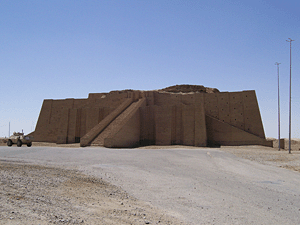
The author's M1117 Armored Security Vehicle is parked next to the 4,000-year-old ziggurat in Ur.
(Courtesy Michael Taylor)
The city of Ur, once the largest in the world and the crown jewel of one of humanity's first civilizations, sits in a wasteland at the edge of a war zone. In late spring, the temperature easily hits 120 degrees as the blazing sun reflects off endless sand flats and yellow Sumerian brick. A 45-minute walk around the site is exhausting even for a very fit person. The ruins, which were inhabited from roughly 3000 to 300 B.C., consist mostly of brick walls, some of which are partially restored, revealing the outlines of monumental complexes such as shrines, storehouses, and elite residences. The ruins are now abandoned, save for a solitary shopkeeper who sits in a ramshackle hut marked "Shop Ziggurat," where he sells trinkets and Mesopotamian-themed souvenirs.
I went to Ur in May 2008 as neither archaeologist nor tourist, but as a platoon leader in an American infantry battalion, responsible for 30 soldiers and 10 gun trucks. The ancient Sumerian city is within Tallil Air Force Base, near Nasiriya, Iraq. Few Westerners have been privileged to see it. In 1999, Saddam Hussein even denied Pope John Paul II access to the site, supposedly the birthplace of Abraham (ca. 1800 B.C.). But since 2003, American military personnel have been able to convoy into Tallil and drive straight into the ruins, putting down rifles and picking up cameras.
Above the tiny shop—we soldiers were its only customers—looms the heart of Ur, the best-preserved ziggurat in all of Iraq. The classic step-pyramid temple consists of two tiers stacked one atop the other, with three converging staircases in front. It is six stories tall and its footprint would fill more than half a football field. In an otherwise barren landscape, it exerts an almost gravitational pull, drawing visitors up the steep yellow steps. It is a great artificial mountain of brick, and long ago it gave the Mesopotamians a brush with their gods.
The ruins of the city cover roughly 30 acres around the ziggurat. As one walks through the larger site, potsherds crunch underfoot. It is impossible not to step on them. The Sumerians simply tossed their rubbish in the streets, gradually raising the level of their cities as garbage accumulated over hundreds of generations. And a few hundred yards from the ziggurat, there is the great necropolis of Ur, where dozens of tombs and pits lie open, their inhabitants removed by British archaeologists decades ago.
When my platoon visited the site, I was the officer in charge. At most tourist sites, you have to wait in line, purchase a ticket, and see things under the supervision of custodians and docents. But in Ur we were free to wander and enjoy a few rare moments of peace. Most of our time in-theater was spent sucking sand, dealing with military snafus, and worrying about getting blown up. Ur was a fleeting opportunity, in the calm of the empty ruins, to take in this exotic land.
That May, our unit, the 1-160th Infantry of the California National Guard, was wrapping up a year in Iraq. We were citizen-soldiers from all walks of life, hastily mobilized and with the unglamorous mission of escorting food, fuel, and equipment from Kuwait to the fight up north. Most of our stretch was defined by tedium, punctuated by moments of terror—exploding roadside bombs or incoming rockets. My platoon was fortunate to suffer no casualties caused by the enemy.
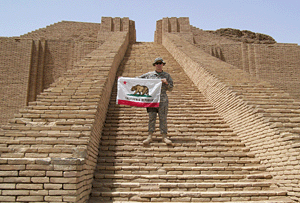
The author, from the 1-160th Infantry of the California National Guard, poses on the steps of the ziggurat at Ur. Few Westerners were able to visit when Saddam Hussein was in power, but since 2003, American military personnel have had easy access to the site.
(Courtesy Michael Taylor)
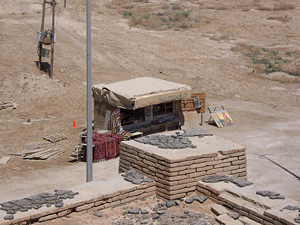
This 2008 photo shows the shop that sits at the base of the ziggurat. Visible in the foreground is the monument's bitumen mortar. The sticky black substance helped preserve the structure, and is one of the first uses of southern Iraq's oil fields.
(Courtesy Michael Taylor)
A typical mission involved linking up with a long line of civilian trucks and convoying through a desolate stretch of southern Iraq, as barren as the moon. At night the desert glowed from the thousands of oil wells. Finally, as we turned onto Iraq's Highway One, a modern if somewhat decrepit road, we would begin the most dangerous part of our trip, where every dead donkey or pile of trash might be rigged to explode. Just shy of the Euphrates River, we could see the landmark that signaled the end of the trip: the ziggurat, a monument that has stood mute witness to 4,000 years of human conflict.
Ur was one of a series of Sumerian city-states that arose in Mesopotamia roughly 5,000 years ago, fueled by agricultural surpluses and dominated by an elite that maintained the complex irrigation systems upon which the city's wealth depended. Around 2250 B.C., Sargon the Great made Ur part of his Akkadian empire, one of the world's first centralized states. Akkadian, a Semitic language distantly related to the modern Arabic now spoken there, gradually replaced Sumerian as Ur's language. Little of the architecture visible today dates to Ur's early history, though artifacts from early tombs can be viewed in the museums of London, Philadelphia, and Baghdad. The city's greatest and most enduring monuments were constructed in the period that followed the collapse of the Akkadian dynasty around 2050 B.C.
In 2047 B.C., Ur became the capital of its own centralized state, ruled by what historians call the Ur III dynasty. Its new king, Ur-Nammu, sought to create monuments to make the city equal to that status, and began construction of the ziggurat temple in honor of the city's patron deity, Nannar, god of the moon. But Ur-Nammu died before his greatest work could be finished, and the project was completed by his son, Shulgi.
The brickwork of the ziggurat attests to the kings' desire to create a lasting monument to their empire. The bitumen mortar—one of the first uses of southern Iraq's vast oil fields—is still visible between the burnt bricks. The sticky black substance, today a source of the region's instability and violence, once literally bound this civilization together. The use of bitumen as mortar and pavement has helped waterproof the otherwise fragile Sumerian mud-bricks, ensuring that the structures endured for millennia.
The ziggurat has always been an important symbol for this region, and two later rulers attempted to adopt it as their own through reconstruction projects. The first was Nabonidus, the last king of the Neo-Babylonian Empire. The second was Saddam Hussein and his Ba'ath Party.
A pious ruler, Nabonidus restored a number of ancient temples in his realm during the sixth century B.C. The exact details of his reconstruction are unclear, but it seems that he built some enormous structure on top of the massive burnt-brick base left by Ur-Nammu, replacing what had been a modest shrine. But where Ur-Nammu used durable bitumen mortar, Nabonidus' builders used ordinary cement. Wind and rain have since reduced his later structure to the heap of rubble that now sits atop the ziggurat. Nabonidus was not rewarded for his piety—he was deposed by invading Persians in 539 B.C. Over the next 2,500 years, Nabonidus' contribution fell to ruin, while Ur-Nammu's original held up.
The Ba'ath Party, which dominated Iraq from 1968 to 2003, was keenly interested in Iraq's Mesopotamian heritage and its potential to unite a population fragmented by sectarian differences. As part of an aggressive program in the 1970s to restore Mesopotamian antiquities, the Ba'athists installed a new facade on the ziggurat's stairways and around the top of the first tier, in addition to making other repairs. A grand festival in 1977 celebrated the restoration, hailing the legacy of Ur-Nammu who, according to the official Ba'ath newspaper, "united the state administratively and politically after it had been divided and split."
Ur, treated modestly by Hussein, was fortunate not to have captured the dictator's self-aggrandizing imagination the way Babylon had. Hussein liked to compare himself to that city's Hammurabi and Nebuchadnezzar II, and ordered an elaborate reconstruction of the Babylonian ruins, transforming them into a gaudy Ba'athist theme park. He even had his name stamped in cuneiform on the new bricks. Ur, on the other hand, received only basic restoration—with modern bricks protecting ancient ones within, thankfully devoid of megalomaniac excess. As a general rule, most of the bricks in the massive first tier of the ziggurat are the originals of Ur-Nammu, while rubble on the second tier dates to Nabonidus. Facade elements, such as the banisters on the stairways, fencing around the edge of the first tier, and the facing on the second tier, are modern restoration.
The Ur III empire founded by Ur-Nammu was overrun around 1950 B.C. by Elamites invading from the east, a disaster memorialized in haunting Sumerian laments:
Ur—inside there is death, outside there is death
Inside we succumb to famine
Outside we are dispatched by Elamite blades.
The city, however, endured and was eventually subordinated under successive empires of Babylonians, Kassites, Assyrians, Neo-Babylonians, Persians, and (briefly) Macedonians. At some point after the Persian invasion in 539 B.C., the Euphrates shifted to the north and east of the city, transforming Ur from prime riverfront property to the center of an expanding desert. While a tablet found at Ur that mentions Philip Arrhidaeus, Alexander the Great's half-brother, states that the site was inhabited as late as 316 B.C., it was more or less abandoned for the next 2,200 years.
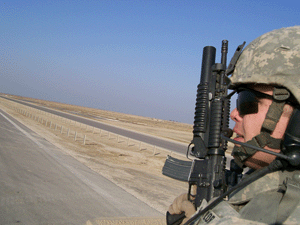
The author waits at a checkpoint located about a mile from the ruins of Ur.
(Courtesy Michael Taylor)
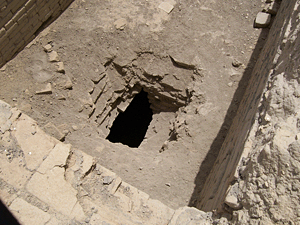
A tomb in Ur's necropolis complex was one of many excavated by Leonard Woolley in the 1920s and 1930s.
(Courtesy Michael Taylor)
As I walked around the site in 2008, I could see evidence of archaeological activity: great tells of dirt and ceramic sherds. In 1854, James E. Taylor, the British consul at Basra, conducted an excavation at Tell al-Muqayyar, the "Mound of Pitch," so named by the locals for the bitumen mortar visible in it. He revealed the crumbling ruins of the ziggurat, as well as cuneiform tablets that identified the site as the biblical "Ur of the Chaldees," birthplace of Abraham in Genesis. There were a few minor British digs in the waning years of World War I, but the landmark excavation of the site was conducted between 1922 and 1934 through a joint expedition sponsored by the British Museum and the University of Pennsylvania. The chief archaeologist was Leonard Woolley, an experienced Near East excavator who had previously dug in Syria with T.E. Lawrence. The dig captured the public imagination and proved curiously conducive to romance. Woolley married his assistant Katherine Merke in 1927. When a charming divorcee named Agatha Christie visited the site, she caught the eye of another archaeologist, Max E.L. Mallowan, 14 years her junior, and the couple married in 1930. Katherine Woolley quickly came to detest Christie, who was subsequently banished from the dig. Mallowan lamented that "there was only room for one woman at Ur," and spent the first dig season after his marriage separated from his bride. The dig at Ur inspired Christie's 1936 mystery novel Murder in Mesopotamia, in which the archaeologist's sickly wife, Mrs. Leidner, is brutally murdered. Similarities between the victim and Katherine Woolley were not exactly accidental.
Woolley's most dramatic finds were in the necropolis, where he uncovered the remains of around 1,850 people from all stages of the city's life. He defined 16 tombs as "royal," and identified a grisly burial practice: Human sacrificial victims were arranged around the royal dead, producing what he dubbed "death pits." The largest of these, the "Great Death Pit," contained the bodies of 68 women and six men.
Woolley especially excelled in the excavation of delicate objects. He extracted fragile artifacts (such as the two "Ram in a Thicket" statues) by coating them in melted wax before removing them. Noticing two voids in the earth left by decaying organic matter, he carefully filled them with plaster, producing a precise cast of a lyre. Woolley continued excavating until diminishing finds and funds forced an end to the expedition. There has not been an excavation at Ur since.
Though only soldiers see Ur today, the ruins have largely escaped the worst effects of modern warfare. The site was incorporated into a Hussein-era military base, which was strafed by Allied warplanes during the First Gulf War, causing minor collateral damage. The city was in turn occupied by U.S. forces in 2003, which prevented the orgy of destructive looting that took place at other ancient Iraqi sites. While we were subject to mortar and Katyusha rocket attacks at the base, there does not appear to have been any significant damage to Ur itself.
In 2009, U.S. military authorities turned the site of Ur over to the Iraq State Board of Antiquities and Heritage. The future of Iraq remains precarious, as sectarian violence between Sunnis and Shiites continues to wrack the country and the Iraqi Army begins to take over security duties. But Mesopotamian sites such as Ur represent a glimmer of hope. If there is a dramatic reduction in violence, international tourism revenues from Mesopotamian archaeology could be substantial. Thriving archaeological activity might also help regenerate a once-vibrant Iraqi intelligentsia depleted by violence and emigration. More importantly, ancient Mesopotamia retains the potential to serve as a rallying point and common heritage for a responsible Iraqi nationalism that transcends sectarian divides.
Our visit to Ur was short. Soon it would be time for another mission. We put away our cameras, suited up in our body armor, and loaded magazines into our rifles. The only way for a Westerner to visit Ur in 2008 was to come ready for war, in armored vehicles bristling with machine guns. Hopefully someday soon, people from across the world will peacefully tour what we saw as soldiers.
Michael Taylor served as a platoon leader in Iraq from 2007 to 2008. He is currently a graduate student in history at the University of California, Berkeley.
Advertisement

Advertisement







